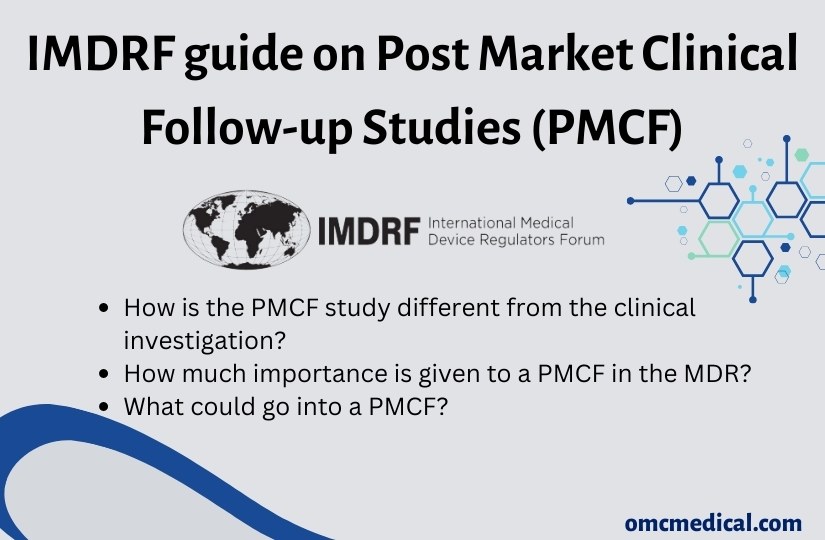PMCF is a continuous process that updates the manufacturers’ clinical evaluation during the Post-market surveillance. They must collect user feedback, clinical data, and all other clinical experiences.
This article provides an overview of the design, implementation, and appropriate use of PMCF studies. these are an integral part of PMS reports.
There may be some data limitations during the premarket phase, like the duration of the investigation and the number of subjects involved or restrictions in the applicability of clinical data. Also, a complete diagnosis of all the potential risks and benefits is impossible during the premarket phase.
Post Market Clinical Follow-up (PMCF) is a study to answer specific questions like safety, clinical performance, or effectiveness of the medical devices according to their labelling from the routine use of the clinical practice.
PMCF studies address the uncertainties in the benefits or risks of medical devices like:
- Unanswered questions about long-term safety, performance, and effectiveness of the clinical data
- Novel/Innovative technologies used in the design, materials/products, and principles of the medical devices
- Uncertainties in generating results from the study population to other populations like adults to children
- Urgent market access due to emergencies like pandemics
- Rare adverse events which can be identified using large datasets
- Adequacy of mitigation
PMCF studies/reports must be conducted based on applicable laws, regulations, and ethical requirements. The personal information about the patient should be very confidential, and the documents must be approved with ethics committee under proper consent. Specific guidance and standards to be followed like:
- Clearly stated objectives
- Scientifically sound study design
- Appropriate study plan
Design and Implementation
Factors that need to be considered during the design of PMCF studies:
- The study settings such as locations must be clearly described
- Study population like inclusion and exclusion criteria should be clearly described
- Comparison/Control groups should be justified
- The sample size should be clearly stated
- Adverse events, risk factors, confounding factors and all other measures should be identified
- To minimize the loss, frequent follow-up of the type and duration of the patient
- Statistical analysis like missing data and modifications should be clearly described
Factors to be considered during the implementation of the PMCF study plan:
- Data collection: Data should be evaluated according to the validated measurement methods
- Quality control: Ensure good quality, proper training, selection, and supervision should be performed
- Final report and interpretation: Demonstrating conclusion based on the original objectives or hypothesis
Based on all the above factors, there might be changes that impact the clinical evaluation and risk management process. Hence, the medical device must be reassessed to comply with the essential principles / general safety performance. Such assessments may include:
- Changes in labelling/IFU
- Changes in the manufacturing process
- Changes in the design of the device
- Sometimes, the removal of some product
PMCF studies state that the data source collected from real-world clinical experience is essential. Examples of such data are as follows:
- Patient-generated health data: Patient report outcome or health data collected from the patient, family members or their caregivers
- Device registry: A system that collects data, results and the population that got exposed to that medical device
- Health record: The medical record that the health care provider has maintained over the period
- Administrative data: Data like health insurance claims
- Survey data: Data collected by the survey from health professionals, patients/customers
Bias and Confounding
Potential bias is a deviation caused by overestimating or underestimating the treatment effects. Confounding is the distortion that occurs when the study group differs from the other factors. Some methods to control bias in PMCF study include:
- Appropriate selection of study population
- Use of validated survey instruments
- Training the staff according to the standard
- Avoid loss during the follow-ups
- Selection of proper statistical data
FAQs
How is the PMCF study different from the clinical investigation?
PMCF, as it states, is the post-market study conducted for a CE-marked device to evaluate the device’s safety performance, whereas the clinical investigation is performed for a device to be CE-marked.
How much importance is given to a PMCF in the MDR?
PMCF is understood to be a continuous process in the device life cycle, and every class of device must have a PMCF plan established to proactively collect and evaluate the clinical data. The analysis of a study must be documented in the PMCF evaluation report, which is a part of the CER and the technical documentation.
What could go into a PMCF?
· Complete clinical data with user feedback
· Any specific methods include during the PMCF study or survey
· Clinical Evaluation Report (CER)
· Address any harmonized standards used in the PMCF plan
· PMCF objectives
Disclaimer: Regulations/legislations are subjected to changes from time to time and the author claims no responsibility for the accuracy of information.







